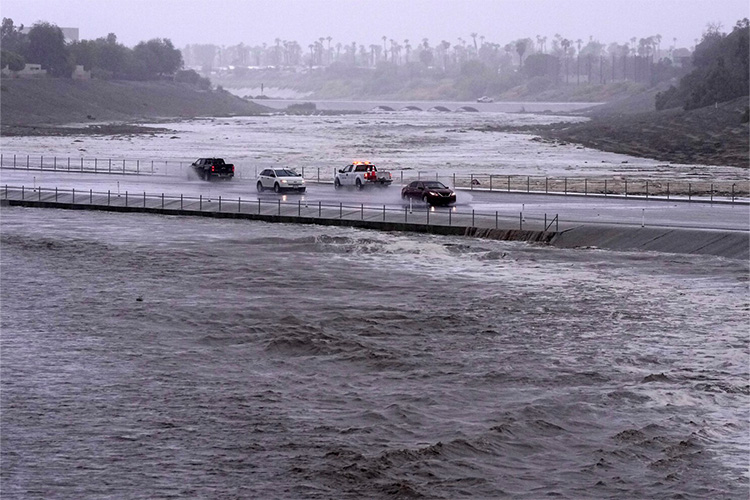
A bridge in California flooded by Hurricane Hilary. photo by Mark J. Terrill
For the first time in almost a century, a hurricane has hit the Pacific West Coast.
From August 16th through the 21st, Hurricane Hilary struck the Pacific Gulf of Mexico and the Baja California Peninsula. Hilary was a Category 4 hurricane which formed next to Mexico. It turned into a record-breaking tropical storm that hit Baja, California. Two months later, the cities are working to restore all that was destroyed from tremendous amounts of rain and mud.
NASA first reported Hurricane Hilary on August 16, where it appeared as a tropical storm the next day at 6 a.m.. It was declared an official hurricane and continued to grow quickly, becoming a Category 2 at 12 p.m., Category 3 by 6 p.m., and a Category 4 by midnight. By this time, it had grown to its max a couple hundred miles from the Baja Peninsula; by the 18th, Hilary had started to turn more towards the Pacific Northwest. By the 20th, it had passed Mexico and turned into a tropical storm due to the perfect conditions for storm growth: stable air, cool water, and wind shear. The major difference between a hurricane and a tropical storm is the wind cycles: hurricanes occur when wind speeds reach 74 miles per hour, whereas tropical storms achieve speeds of between 39-73 mph.
While hurricanes happen every year, the places in the U.S. that get hit the most are in the Eastern/Southern Atlantic Coasts. From June to November, hurricanes in the Atlantic are very common, which many Americans are aware of. However, what may shock some is that hurricanes in the Pacific happen almost more than those in the Atlantic do. Though, very rarely do hurricanes actually hit the coast of the U.S., which is why Hurricane Hilary is such an abnormal storm. The last hurricane to strike California was on September 25, 1939 – 84 years ago.
The most important factor that keeps hurricanes moving is the temperature of the water they travel on. For a hurricane to form, the temperature of waters must be above 80 degrees Fahrenheit. If the temperature is any lower, the hurricane cannot form and can cause the storm to break. Waters around the Pacific West are an average of 38 degrees Fahrenheit, meaning that hurricanes usually do not travel close to California’s coast. What makes Hilary so special is that she was very close to California when she was still at her peak. By the time she was starting to die down, she had already hit California, where she degraded to a tropical storm on land.
Even two months after the hurricane, the places hit are still affected by the aftermath of the severe weather. Multiple cities were hit with high winds and heavy downpour, resulting in floods and even isolated tornadoes. LAist exemplified the emergencies during the storm: A freak accident in Cathedral city resulted in 46 rescues due to insane mud trapping in a retirement home. Fire fighters all over California for multiple days were called to scenes of people trapped in flash floods, stuck in heavy mud, injured, caught in landslides, and more. In some places, there were up to 5 meters of rain or mud. Not only that, but it was difficult to even get to some of the people in need of rescue through all the mud, rain, and humongous boulders standing in the way. The storm obliterated records of fallen rain in cities across California.
Officials estimate the damages will result in $126 million worth. Some cities were left relatively alone, whereas others will have to restore electrical poles, bridges, streets, homes, buildings, etc. that will cost money, time, and resources to rebuild successfully. Hurricane Hilary has both been historic in its damages and its rare appearance along the Pacific Coast.